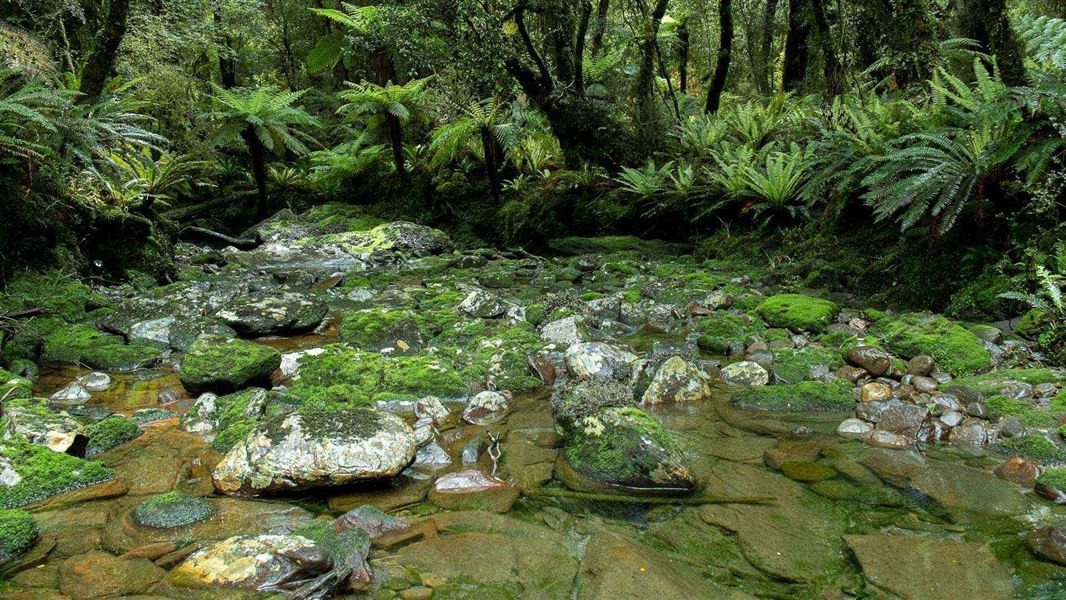Image gallery
Walking the Haast to Paringa Cattle Track is a three-day journey and you will need to be prepared to stay in huts along the route.
SH6 to Blowfly Hut
Time: 1 hr 30 min
The initial section of the track to Blowfly Hut detours from the original route to avoid a lowland swampy area around Windbag Creek. Once past the swampy area, it soon picks up the original line.
The flat well-benched track then follows the Moeraki River to a junction about 1 hour’s walk away. Blowfly Hut is a further 15 minutes’ walk from this junction, across the swing bridge to your left. There's a turn-off to your right just before Blowfly Hut that you need to take to continue the Historic Haast to Paringa Cattle Track.
Blowfly Hut to Māori Saddle Hut
Time: 4 hr 30 min
The track to Māori Saddle winds its way steadily uphill through mixed beech, rimu and kāmahi forest, typical of southern Westland. Along the way, you'll pass some good examples of stone culverts built by the mica miners.
There's also a historic miner’s campsite near the helipad, 5 minutes before the Mica Mine Tops Route junction. Continuing towards Māori Saddle, sections of the track are quite rough – in heavy rain, access becomes more difficult due to the numerous stream crossings. Crossings are marked, but the rocks are very slippery, so take care.
There are some diversions where slips have destroyed the original track, however, these are well marked and should not be difficult to follow. There are some very large specimens of beech trees along this section. There are also some relics of the historic ‘telegraph line’ that ran beside the track.
Mataketake Hut turnoffs
Mataketake Hut can be started from two points on the Historic Haast to Paringa Cattle Track:
- The first is Mica Mine Tops Route around 2 hours from Blowfly Hut.
- The second is Māori Saddle Route signposted 10 minutes past Māori Saddle Hut.
Coppermine Creek Hut
Time: 7 - 9 hr
This longest section of the track is downhill most of the way. Follow the markers on the other side of diversions where vegetation is overgrown and at windfalls and slips especially at Slippery Face near Robinson Creek where the track crosses the alpine fault line.
Eventually the track swings to the north and follows a fence-line towards Coppermine Creek where the DOC hut is on the “true right” of the creek and the furthest of the three huts. It is another two-hour walk to the highway.
Access to the north end of the track is signposted approximately 40 km northeast of Haast on SH6 at the Windbag Saddle. There is a small parking area on the side of the road (the sign is labelled Haast - Paringa Cattle Track).
The sound end of the track is marked by a gate just south of the Waita River Bridge about 11 km north of Haast Junction.
- For track conditions, maps, weather forecasts and more information on the area contact the Haast Visitor Centre.
- The route is well marked and has a wide walking width of about two metres for most of its length, but you can expect to encounter slips and fallen trees in places.
- The relevant maps you will need to carry are Topomap F37 Haast and a G37 Landsborough.
- Windfalls and slips are common and diversions may be necessary.
- The track crosses numerous small creeks, which flood quickly in heavy rain, and you should wait until water levels drop before proceeding.
Stay safe when crossing rivers
If you plan to cross unbridged rivers, know how to cross safely and be prepared for if you cannot cross.
Do not cross if the river is flooded, you cannot find safe entry and exit points or are unsure it’s safe. Turn back or wait for the river to drop. If in doubt, stay out.
In 1875 pioneer farmers at Haast constructed the cattle track. Stock from farms in the Landsborough and Cascade Valleys were driven to sale yards at Whataroa, a two-week journey at best.
In mobs of around 200, the cattle were grazed overnight on flats near Coppermine Creek. It took around 14 hours to make the 17 km journey to Blowfly Hut next day. From there the cattle were herded across the Moeraki River and on to Lake Paringa.
It is thought that nearly 50,000 cattle travelled the route throughout its history, with a maximum of about 700 per year in the 1940s. In 1961 the last mob was driven through to Whataroa and the track condition deteriorated. In 1965 the route through the Haast Pass (SH6) opened. In 1981 the old Cattle Track reopened as an historic walk in the Te Wahipounamu South West New Zealand World Heritage Area.
Stay safe in the outdoors
- Choose the right trip for you. Learn about the route and make sure you have the skills for it.
- Understand the weather. Check weather forecasts.
- Pack warm clothes and extra food. Check gear lists.
- Share your plans and take ways to get help. Share directly or use the Outdoor Intentions form or Plan My Walk. Take a distress beacon.
- Take care of yourself and each other.
Awarua/Haast Visitor Centre
| Phone: | +64 3 750 0809 |
| Email: | haastvc@doc.govt.nz |
| Address: | Haast Junction Corner SH6 and Jackson Bay Road Haast 7886 |
| Hours: | Visitor centre hours and services |
